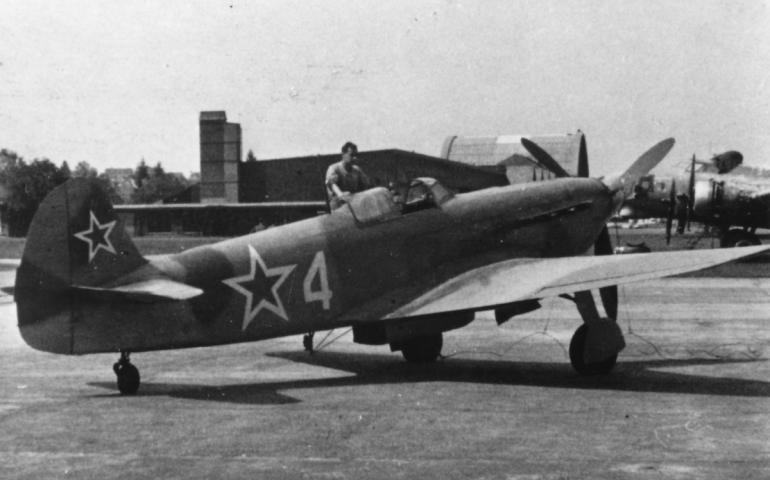
On August 25, 1945, a Russian fighter plane had to make an emergency landing. A search for clues reveals how Switzerland handled the delicate situation.
The watch commander at Dübendorf air base could not believe his eyes when he looked through his binoculars at 8:45 a.m. on August 25, 1945. From the northwest, a fighter plane never before seen here was approaching, trailing a strong plume of smoke and with unmistakably Russian markings.
Countless American, British and German aircraft found refuge in Switzerland during World War II; the Dübendorf military airfield developed in the course of this time into a huge open-air museum of more than 150 aircraft, mainly bombers, side by side, fuselage to fuselage. And now a modern Russian fighter was to be added.
The JAK-9 made a normal landing and then taxied to the main hangar. The firefighting crew on duty noticed smoke in the ammunition box, whereupon it was immediately removed. The JAK-9 and the pilot, Captain Kashnikov, were immediately interned.
Wait and see by the authorities
The responsible authorities were now confronted with a delicate case. For reasons of neutrality policy, Switzerland was not allowed to return a fighter to a belligerent country; at that time, the Soviet Union was still in a state of war with Japan, which did not surrender until September 2, 1945. Negotiations on the return of the aircraft subsequently proved difficult, as Switzerland did not maintain diplomatic relations with the USSR. As often in the past years of war, the motto was: wait and see.
Meanwhile, the wish of JAK pilot Kaschnikov was conscientiously fulfilled by the Dübendorf aircraft mechanics: To prevent corrosion damage, the aircraft engine was moved by hand every two days. Finally, there was some movement in the handling of this matter. Unfortunately, the files in the Swiss Federal Archives do not reveal the channels through which the initiative passed, but the way to diplomatic relations was paved. On November 8, 1945, a Russian C-47 (DC-3) finally landed in Dübendorf for the purpose of transporting back 15 Russian internees.
And it continued: On December 14, 1945, seven officers and two NCOs were flown into Dübendorf by the Soviets to repair the damage done to the JAK-9 and make it ready for the return flight. These repairs took several days, so the Russian detachment was quartered at the Hotel Stadthof in Zurich Oerlikon; the food was reportedly found to be good. The Swiss aircraft mechanics had the impression that their Russian colleagues knew exactly the work assigned to them on the aircraft engine, but did not always perform it well and reliably. It is said to have happened frequently that bolts and nuts were tightened or loosened with chisels and hammers.
Latent distrust
Some maintenance work on the JAK-9 had to be performed by the local airfield personnel (DMP) themselves. Before the usual check flight by Russian pilot Kashnikov, 500 liters of aviation gasoline, 60 liters of lubricant, and a set of new spark plugs were provided. Captain Kaschnikov was present as a controller during all the operations - latent distrust was palpable. However, the willingness of the Swiss mechanics was expressly acknowledged.
Shortly after Christmas, on December 29, 1945, at 1 p.m., the repaired JAK-9 took off from the runway in Dübendorf for the return flight via Munich-Schleissheim to Vienna, which was then a Soviet occupation zone. At the same time, the Russian military commission led by General Vichorev, who had conducted the negotiations on the Russian internees in Switzerland, and the deployed standby detachment leave Switzerland by air with a C-47.
After Swiss Foreign Minister Marcel Pilet-Golaz's foreign policy debacle with the Soviet Union in 1944, Switzerland had learned its lesson. Now - after Federal Councillor Max Petitpierre had taken over the Federal Political Department - it was time to normalize relations with one of the victorious powers of the Second World War.
On March 18, 1946, diplomatic relations between Moscow and Bern were officially established. The Helvetic correct settlement of the JAK emergency landing in the fall of 1945 may have played a part in this.
Source: Neue Zürcher Zeitung, Roger Cornioley